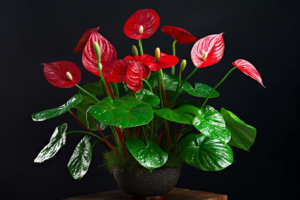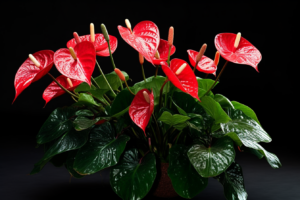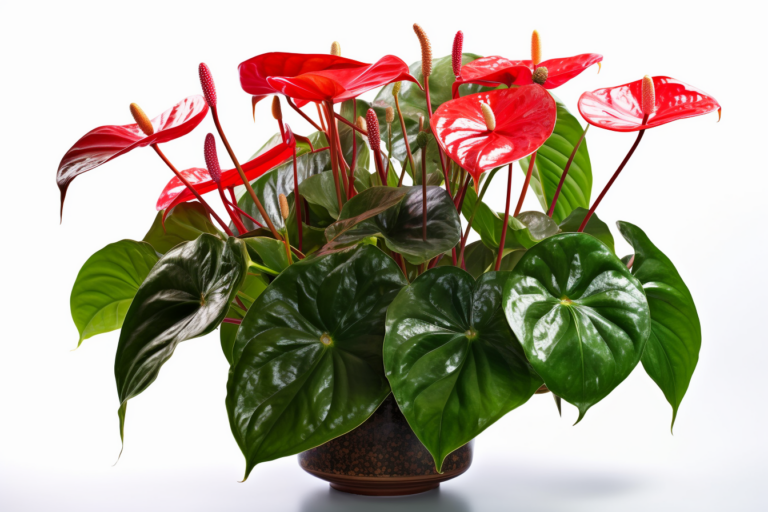Anthuriums are popular houseplants known for their vibrant, heart-shaped flowers and glossy leaves. They are native to tropical regions, and as such, they require specific care to thrive. One of the most critical aspects of anthurium care is watering. So, how often should you water anthurium plants? We’ll answer that question and more in this comprehensive guide.
Understanding Anthuriums
Anthuriums, also known as Flamingo Flowers, are part of the Araceae family. They are epiphytes, meaning they grow on other plants in their natural habitat. This characteristic plays a significant role in determining the proper watering routine for anthuriums.
Epiphytic Nature of Anthuriums
As epiphytes, anthuriums grow on trees or other plants to get nutrients and moisture. They have aerial roots that collect water and nutrients from the air, and they don’t like to be submerged in water for long periods. This epiphytic nature means anthuriums need a well-draining soil mix and a careful watering routine.
Watering Frequency for Anthuriums
In general, anthuriums should be watered once a week during the growing season (spring and summer) and once every two weeks during the dormant season (fall and winter). However, this is only a general guideline, as various factors may influence the watering frequency.
Keep an Eye on the Soil
To determine when your anthurium needs water, check the top inch or two of the soil. If it feels dry, it’s time to water. If it’s still moist, wait a few days and check again.
Factors Affecting Watering Frequency
Several factors can influence how often anthuriums need to be watered, including:
- Season: Anthuriums require more water during the growing season (spring and summer) and less water during the dormant season (fall and winter).
- Temperature: Warmer temperatures cause the soil to dry out faster, which means you’ll need to water your anthurium more often.
- Humidity: Higher humidity levels help retain moisture in the soil, so you may need to water less frequently in more humid environments.
- Pot size and material: Smaller pots and porous materials like terracotta dry out more quickly than larger pots or non-porous materials.
How to Water Anthuriums
Follow these steps to ensure proper watering of your anthurium:
- Water deeply: When watering, thoroughly soak the soil to ensure the roots receive enough moisture.
- Use a well-draining soil mix: A mixture of peat moss, perlite, and orchid bark is ideal for anthuriums, as it provides excellent drainage and mimics their natural habitat.
- Avoid standing water: Ensure excess water drains away to prevent root rot. If using a saucer, empty it after watering.
Signs of Overwatering and Underwatering
It’s essential to recognize the signs of overwatering and underwatering in your anthurium, as both can lead to plant stress and potential damage.
Overwatering Symptoms
- Yellowing leaves
- Wilting, even with moist soil
- Root rot
- Mold or fungus growth
Underwatering Symptoms
- Brown leaf tips
- Drooping leaves
- Slow growth or no growth
- Leaves becoming dry and crispy
If you notice any of these symptoms, adjust your watering schedule accordingly to provide your anthurium with the proper care it needs to thrive.
Best Time of Day to Water Anthurium
As an expert in gardening, I often get asked about the best time of day to water plants. In the case of anthurium, timing is crucial to ensure optimal growth and health. Here are some guidelines to follow:

- Water in the morning: The best time to water your anthurium is early in the morning, preferably before 10 a.m. This allows the plant to absorb the water it needs to thrive, while also giving it enough time to dry out before the heat of the day sets in.
- Avoid watering in the afternoon: While it may be tempting to water your anthurium during the hottest part of the day, this can actually harm the plant. Water droplets on the leaves can act as magnifying glasses, intensifying the sun’s rays and causing burns.
- Don’t water at night: Watering your anthurium at night can create a damp environment that is conducive to fungal growth and disease. It’s best to allow the plant to dry out before the evening.
- Adjust watering frequency based on temperature: During the cooler months, you may not need to water your anthurium as frequently as you would in the summer. Observe the plant’s leaves and soil to determine if it is in need of water.
In general, it’s important to keep in mind that consistency is key when it comes to watering anthurium. Aim to water the plant once a week, or when the top inch of soil feels dry to the touch. By following these tips and guidelines, you can ensure that your anthurium thrives and grows to its full potential.
How Much Water to Give Anthurium
One of the most critical factors in caring for anthurium is watering. Watering anthurium correctly guarantees its health and beauty. Here is what you need to know about how much water to give anthurium.
Determine your Anthurium’s Water Needs
Anthuriums require well-draining soil to avoid root rot. You can check the soil by inserting your finger into it. If the soil is dry, it’s time to water the plant. If the soil is still moist, wait for a few more days before watering it.

Frequency of Watering
The frequency of watering your anthurium depends on several factors, including temperature, humidity, and the size of your pot. In general, it’s advisable to water your anthurium once a week.
During summer, when the weather is hot and dry, you may need to water your anthurium more frequently. Conversely, in colder months, when the room temperature is low, your anthurium will need less water.
Watering Technique
When watering anthurium, use a watering can or a small cup, and add enough water to moisten the soil. Water your anthurium until the water begins to drip out of the drainage holes. Be careful not to over-water your anthurium as it can lead to root-rot.
Factors to Consider
Here are some factors to consider when watering your anthurium:
- Size of the pot
- Humidity
- Temperature
- Exposure to sunlight
Summary
Getting the amount of water right when watering your anthurium is essential for its well-being. Proper watering ensures that the plant receives all the necessary nutrients to remain healthy and produce beautiful flowers. Remember to check the soil regularly, water your plant according to its needs, and monitor the frequency of watering based on the environment.
Creating Ideal Watering Conditions for Anthurium
When it comes to watering anthurium, providing the ideal conditions is key to keeping the plant healthy and vibrant. Here are some tips to help:
Determine Your Anthurium’s Watering Needs
Before creating the ideal watering conditions, you first need to determine your anthurium’s individual watering needs. Factors such as the size of the plant, the quality of the soil, and the environmental conditions can all play a role in how often your anthurium requires water. In general, anthuriums like a consistently moist, but not soggy, soil. You can test the soil by sticking your finger about an inch into the soil and checking for dryness. If the soil feels dry, it’s time to water your plant.
Choose the Right Container
Choosing the right container is also important for creating ideal watering conditions. Anthuriums prefer well-draining containers that allow excess water to escape easily. Containers with drainage holes at the bottom are recommended for anthuriums. If your container does not have drainage holes, consider drilling a few holes at the bottom to prevent the soil from becoming waterlogged.
Use the Right Watering Technique
When watering your anthurium, it’s important to use the right technique. Pour water directly into the soil, avoiding the leaves and stems. Watering can also be done from below, by filling a tray or saucer with water and allowing the soil to absorb the water from the bottom up. This method helps prevent damage to the leaves and encourages deeper root growth.
Monitor Temperature and Humidity
The temperature and humidity in the environment can also affect anthurium watering needs. Anthuriums prefer warm and humid conditions. If the air is dry, your anthurium may require more frequent watering to maintain moisture levels.
Avoid Overwatering
Overwatering anthuriums can lead to root rot and other problems. It’s important to avoid watering your plant too frequently or allowing the soil to become waterlogged. In general, anthuriums require watering every 7-10 days, but this can vary depending on individual plant needs and environmental conditions.
Creating ideal watering conditions for your anthurium can help promote healthy growth and vibrant blooms. With the right container, watering technique, and monitoring of environmental conditions, your anthurium can thrive for years to come.
After thorough research and analysis, it is safe to conclude that the frequency of watering anthurium plants will vary depending on several factors. These factors include the type of potting mix used, the size of the pot, the level of humidity, the temperature, and the amount of light the plant receives.
In general, it is best to allow the top inch or so of soil to dry out before watering your anthurium again. Overwatering can lead to root rot, while underwatering can cause the plant to wilt and potentially die. It’s essential to strike a balance between the two.
One way to determine when to water your anthurium is by testing the soil’s moisture level. You can do this by sticking your finger into the soil up to the first knuckle. If the soil feels dry, it’s time to water. If it feels moist, wait a few more days before checking again.
Another method is to lift the pot. A lighter pot indicates that it’s time to water, while a heavier pot suggests that the soil is still moist enough.
Overall, the key is to observe your plant and adjust accordingly. With proper care and attention, your anthurium can flourish and brighten up your living space for years to come.
How Often to Water Anthurium Plant?
Anthurium plants prefer to be kept moist but not waterlogged, so it’s important to avoid both overwatering and underwatering. In general, you should water your anthurium plant about once a week, or when the top inch of soil feels dry to the touch. However, the frequency of watering may depend on factors such as the size of the pot, the level of humidity, and the amount of light the plant is receiving. It’s always a good idea to check the soil moisture level before watering, as this will help prevent overwatering and ensure that your anthurium stays healthy and happy.
How Often to Water Anthurium in Winter?
In winter, when the temperatures are cooler and the air is drier, you may need to adjust your watering schedule for your anthurium plant. Anthurium plants may require less frequent watering in the winter months because they tend to grow slower and absorb less water. You should still check the soil moisture level regularly by feeling the top inch of soil with your finger. If the soil feels dry, you can water your anthurium plant, but be sure to do so sparingly to avoid overwatering. In general, it’s a good idea to water your anthurium plant every 10 to 14 days during the winter months, or whenever the soil feels dry to the touch. Remember, it’s always better to underwater than to overwater your anthurium plant, as overwatering can lead to root rot and other problems.
How Often to Water indoor Anthurium?
Indoor anthurium plants should be watered when the top inch of soil feels dry to the touch. In general, you should water your indoor anthurium about once a week, but the frequency may vary depending on the environment and the size of the pot. Anthurium plants prefer to be kept moist but not waterlogged, so it’s important to avoid overwatering. To avoid overwatering, make sure the pot has drainage holes to allow excess water to drain out, and remove any standing water that collects in the saucer or tray beneath the pot. It’s also a good idea to mist the leaves with water occasionally to increase humidity around the plant, as anthuriums thrive in a humid environment. Overall, the key to watering an indoor anthurium plant is to monitor the soil moisture level and water only when needed.
FAQS
Can I use tap water for my anthurium?
Yes, you can use tap water for your anthurium. However, if your tap water has high levels of chlorine or minerals, you may want to use filtered or distilled water to avoid potential harm to your plant.
How can I increase humidity for my anthurium?
To increase humidity, you can place your anthurium on a tray filled with pebbles and water, use a humidifier, or group it with other humidity-loving plants.
Should I mist my anthurium?
Misting your anthurium can help increase humidity, but it is not a substitute for proper watering. Make sure to water the plant as needed, in addition to misting.
When should I repot my anthurium?
Repot your anthurium every 2-3 years or when the roots start to outgrow the pot. Choose a well-draining soil mix and a pot that is 1-2 inches larger in diameter than the current one.
What should I do if my anthurium has root rot?
If your anthurium has root rot, remove it from the pot, trim away any affected roots, and repot it in fresh, well-draining soil. Be sure to reduce your watering frequency to prevent future occurrences of root rot.


I found this article very helpful in understanding how often to water my Anthurium. It’s important to not overwater and let the soil dry out a bit before watering again. Thank you!